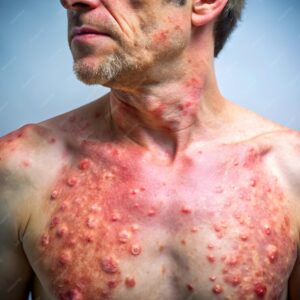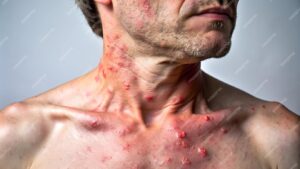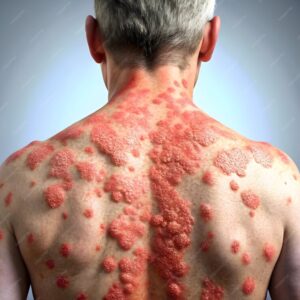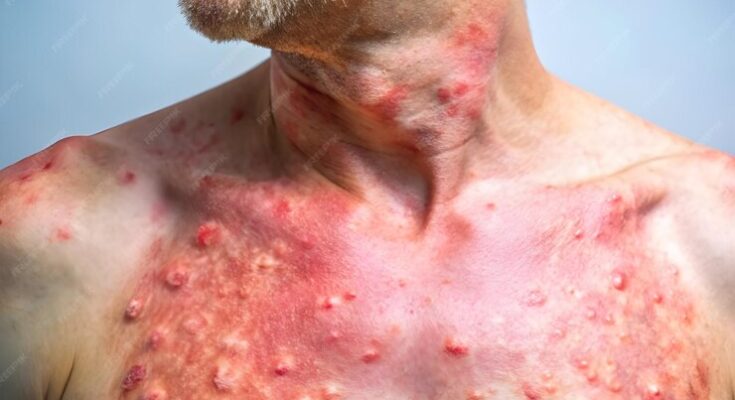Introduction to Psoriasis Vulgaris
Psoriasis vulgaris, often referred to simply as “psoriasis,” is the most common form of psoriasis, a chronic autoimmune disorder affecting the skin. It is characterized by the rapid growth of skin cells that accumulate to form thick, scaly patches. These patches typically appear on the scalp, elbows, knees, and lower back, but they can develop anywhere on the body. Psoriasis vulgaris is not only physically uncomfortable but can also have a profound psychological and emotional impact on individuals due to its visible symptoms.

Pathophysiology
At the core of psoriasis vulgaris is an overactive immune response. Normally, the skin cells regenerate every 28 to 30 days, but in individuals with psoriasis, this process accelerates, with skin cells renewing in just three to four days. This rapid turnover leads to a buildup of cells on the surface of the skin, causing the formation of plaques, which are thick, raised, red, and covered by silvery scales. The underlying immune mechanism involves T-cells, which are a type of white blood cell. These T-cells mistakenly attack healthy skin cells, triggering an inflammatory response that leads to the excessive production of skin cells.
Clinical Features
Psoriasis vulgaris manifests as well-demarcated, erythematous (red) plaques covered with silvery-white scales. These plaques often appear symmetrically, affecting both sides of the body. The most common locations include:
- Scalp: Dry, flaky patches that may lead to hair loss.
- Elbows and Knees: Thickened, scaly lesions that can be particularly painful due to frequent friction.
- Lower Back and Lumbosacral Area: Larger plaques can form here, sometimes causing discomfort during movement.
The affected skin areas can be dry and may crack, leading to painful fissures. In more severe cases, psoriasis can lead to joint involvement, known as psoriatic arthritis.
Triggers and Risk Factors
Although the exact cause of psoriasis vulgaris is not fully understood, several factors contribute to its onset and exacerbation. Genetic predisposition plays a significant role; family history is a known risk factor. Environmental triggers, however, also play a key role in flare-ups, including:
- Infections: Streptococcal throat infections, in particular, are known to trigger guttate psoriasis, a form of psoriasis vulgaris.
- Stress: Psychological stress can worsen symptoms and potentially trigger flare-ups.
- Medications: Certain drugs, including lithium, beta-blockers, and antimalarial drugs, have been linked to exacerbating psoriasis.
- Weather: Cold, dry climates can worsen symptoms, while sunlight can have a therapeutic effect for many patients.
- Injury to the Skin: This is known as the Koebner phenomenon, where trauma (such as cuts, burns, or tattoos) to the skin can trigger new psoriatic lesions at the site of injury.

Diagnosis
Psoriasis vulgaris is usually diagnosed through clinical examination, with its characteristic appearance being the main diagnostic criterion. In some cases, a skin biopsy may be performed to rule out other conditions and confirm the diagnosis. Laboratory tests are generally not necessary unless there are concerns about systemic involvement, such as psoriatic arthritis.
Treatment Options
Managing psoriasis vulgaris involves both symptomatic treatment and addressing the underlying immune dysfunction. The main treatment strategies include:

- Topical Treatments:
- Corticosteroids: The most commonly prescribed treatment, corticosteroids help reduce inflammation and itching.
- Vitamin D Analogs: These include calcipotriene, which helps slow down skin cell production.
- Topical Retinoids: These help reduce cell turnover and inflammation.
- Phototherapy:
- Ultraviolet B (UVB) light therapy is commonly used to treat widespread or persistent psoriasis vulgaris. It helps slow down the growth of skin cells.
- Systemic Medications:
For moderate to severe cases, systemic treatments may be required:- Methotrexate: An oral immunosuppressant that reduces skin cell turnover.
- Cyclosporine: An immunosuppressant used in more severe cases.
- Biologics: These are newer agents that target specific parts of the immune system involved in the development of psoriasis. Biologics like TNF inhibitors (e.g., etanercept) and IL-17 or IL-23 inhibitors (e.g., secukinumab, guselkumab) offer more targeted therapy.
- Lifestyle and Home Remedies:
- Moisturization: Regular use of moisturizers can help alleviate dryness and reduce scaling.
- Avoiding Triggers: Identifying and managing personal triggers, such as stress, smoking, and alcohol consumption, can help in reducing flare-ups.
Impact on Quality of Life
Beyond the physical symptoms, psoriasis vulgaris can significantly affect an individual’s quality of life. The visibility of the skin lesions can lead to feelings of embarrassment and social stigma. Patients often experience anxiety and depression due to the chronic nature of the disease. The constant need to manage flare-ups can also be emotionally exhausting. It is essential for healthcare providers to address both the physical and psychological aspects of the disease when treating psoriasis vulgaris.
Conclusion
Psoriasis vulgaris is a common and chronic skin condition that can be managed but not cured. With a variety of treatment options available, from topical treatments to biologics, individuals with psoriasis can find strategies to control their symptoms. Early diagnosis and individualized treatment plans are key to managing this condition and improving the quality of life for those affected. As ongoing research continues to explore the immune mechanisms behind psoriasis, new and more effective treatments are likely to emerge, offering hope for better long-term management of this challenging skin disease.



